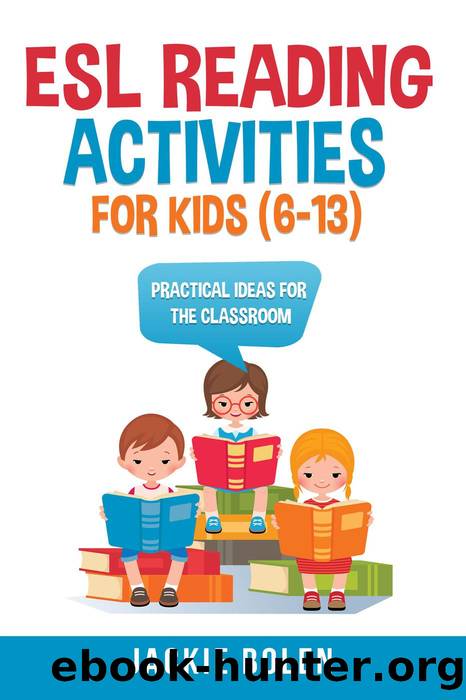ESL Reading Activities For Kids (6-13) by Jackie Bolen

Author:Jackie Bolen
Language: eng
Format: epub
Tags: ell reading activities, esl reading activity, esl reading activities, esl reading comprehension, esol reading exercises, esl reading, esl reading games
Publisher: Jackie Bolen
Published: 2020-06-01T00:00:00+00:00
Dialogue Substitution
Skills: Reading/listening/speaking
Reading Sub-Skills: Reading out loud, predicting, inferring meaning from context
Time: 10-15 minutes
Level: Beginner
Materials Required: PowerPoint or handouts of photocopied textbook dialogue with parts removed.
Lower level textbooks contain many dialogues but their effectiveness is reduced when students donât have to listen to their partner in order to successfully complete their role. An easy solution to this is to provide the dialogues with key elements missing. In this case, you may want to remove key grammatical elements out of the conversation. For example, you could use this activity to work on subject-verb agreement if you leave the verb out. Or, you could leave the subject out as well.
Students then have to listen in order to respond appropriately. Dialogues are an excellent way for students to see how new grammar is used in real-life situations.
In terms of reading skills, there are a number of things this activity can help our students with. Perhaps most importantly, students have to use the context to infer meaning and figure out the appropriate word. They can also predict what will come next and work on reading out loud.
You may need to scaffold this activity by providing a list of possible grammar patterns that could be used to fill the gaps. Alternatively, you can make the activity more difficult or realistic by allowing students to complete the dialogue using any language that makes sense, even if it hasnât been presented in that lesson.
This activity is also useful for reviewing some basic conversation strategies: asking a speaker to repeat what he/she has said or asking for clarification (as well as others). This is an area where students may need a bit of scaffolding, such as a few ways to politely ask others to repeat themselves:
One more time, please?
Sorry, I didn't understand.
Also, remind students that when they speak to someone, they should be looking at the person, rather than at a handout or screen.
Teaching Tips:
This can work with any size class, but you may need to remind students to use their âinside voices.â Also be sure to circulate around the class monitoring their language choices and making corrections as needed.
Procedure:
1. Before class, scan or photocopy a textbook dialogue with the target language (a grammatical point) removed.
2. Optionally, create a list of possible words or phrases that students can use to complete the dialogue or encourage students to use other words or phrases that will fit the target language. Also, introduce any language needed for practicing communication strategies (see above).
3. Divide students into pairs and have them take turns being A and B.
4.To extend the activity, have students change partners and repeat the dialogue, using different words to create a new conversation.
Download
This site does not store any files on its server. We only index and link to content provided by other sites. Please contact the content providers to delete copyright contents if any and email us, we'll remove relevant links or contents immediately.
Cecilia; Or, Memoirs of an Heiress — Volume 1 by Fanny Burney(31351)
Cecilia; Or, Memoirs of an Heiress — Volume 3 by Fanny Burney(30949)
Cecilia; Or, Memoirs of an Heiress — Volume 2 by Fanny Burney(30907)
The Lost Art of Listening by Michael P. Nichols(6484)
We Need to Talk by Celeste Headlee(4881)
Asking the Right Questions: A Guide to Critical Thinking by M. Neil Browne & Stuart M. Keeley(4599)
On Writing A Memoir of the Craft by Stephen King(4221)
Dialogue by Robert McKee(3593)
I Have Something to Say: Mastering the Art of Public Speaking in an Age of Disconnection by John Bowe(3520)
Pre-Suasion: A Revolutionary Way to Influence and Persuade by Robert Cialdini(3422)
Elements of Style 2017 by Richard De A'Morelli(2946)
The Book of Human Emotions by Tiffany Watt Smith(2779)
Good Humor, Bad Taste: A Sociology of the Joke by Kuipers Giselinde(2559)
Name Book, The: Over 10,000 Names--Their Meanings, Origins, and Spiritual Significance by Astoria Dorothy(2496)
Fluent Forever: How to Learn Any Language Fast and Never Forget It by Gabriel Wyner(2451)
The Grammaring Guide to English Grammar with Exercises by Péter Simon(2397)
Why I Write by George Orwell(2362)
The Art Of Deception by Kevin Mitnick(2303)
Don't Sleep, There Are Snakes by Daniel L. Everett(2220)
